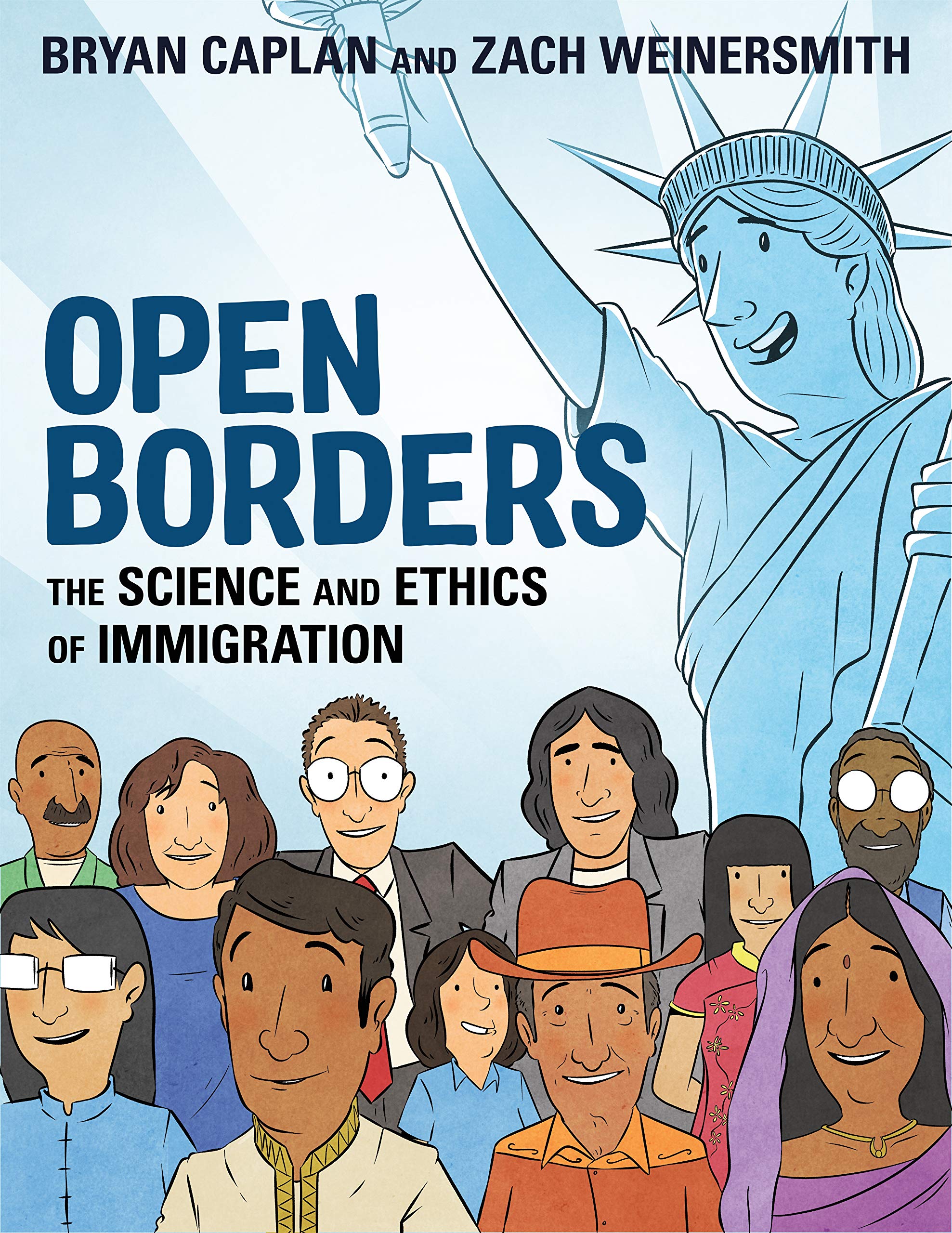
There were a number of interesting comments on my post in which I highlighted my review of co-blogger Bryan Caplan’s book Open Borders. Because few people read comments but I thought some of the comments worth responding to, I’m doing so here.
I’ll state each comment and then respond.
mike writes:
if you call charging $50k per admission (and also perhaps higher tax rates..so say maybe an additional 10% on average 50-100k salary, so 5-10k more per year in revenue, so a net $100-150k in “fees / taxes” in first decade”) open borders, then I am all for it, and in fact think most conservatives would be for it, but no way most liberals would be for it, and there is no way that can actually be called “open borders” can it?
Do many other people here consider that to be open borders? I ask sincerely, because if that is, I totally support that plan. Because the reality is the only way that plan would happen is then for college educated and somewhat well to do immigrants would come here…(either through direct savings, or through employers paying a fee / bonus for the $50k etc). Immigrants doing “jobs americans won’t do” can by no means actually afford the $50k.. nor would their employers pay them that. I am baffled by this, and pretty much wrote caplan’s non-worry about open borders as ridiculous, but if he would be down for the $50k fee (is he btw? i think that is your figure David correct?) then i support the plan / idea of “open borders”
My response:
I should have clarified. The $50K and the additional 10 percentage point tax shouldn’t be done together. The $50K on its own would be enough. I agree that it’s not open borders; it’s “more-open borders.”
I strongly disagree with the statement that such a fee would cause only the well-to-do and highly educated to come here. The reason is that illegal immigrants pay 4-digit and 5-digit amounts now to come here illegally. And for that, they take a risk of dying, especially if they cross the desert, and still have to deal with the fact they are illegal. So they are always in danger of being hunted down and deported. The amount they would pay to be here legally, therefore, would be substantially higher. Here’s what immigration analyst Alex Nowrasteh wrote about the issue in 2012:
Costs vary widely based on the mode of transport, distance travelled, the number and characteristics of those being moved, price discrimination, and local conditions like the cost of avoiding detection by immigration authorities. Unauthorized Mexican immigrants usually pay $4,000 to cross the border on foot or $9,000 by boat and there are an estimated 6.6 million of them living in the U.S. as of 2010. The smuggling fee for unauthorized Central American immigrants is currently between $7,000 and $10,000. In 2010, there were an estimated 1.5 million unauthorized immigrants from El Salvador, Guatemala, and Honduras residing in the U.S. The smuggling fee for an unauthorized Chinese immigrant is about $75,000 and there about 130,000 unauthorized Chinese immigrants in the U.S. as of 2010. The most recently compiled averages in 2005 show that Asian unauthorized immigrants pay $26,041 to come to America, Europeans pay $6,389, and Africans pay $2,200.
Fred writes:
Isn’t the argument about open borders moot? In fact, aren’t our borders pretty open? There are reportedly more than ten million border crossers. Surely, every Mexican who wants to come is already here. Chinatown is growing rapidly in NYC without the benefit of green cards. When the economy in Ireland was sluggish, Boston was full of Irish guys. We argue about legalities but ignore realities. It’s similar to drug laws; laws create black markets that have undesirable externalities.
No, it’s not moot. Our borders are not pretty open. I think by his statement “There are reportedly ten million border crossers,” he means “there are over ten million illegal immigrants.” All you need to look at is the differential in wages between poor countries and the United States–check out my review–to see that there would be many millions and probably tens of millions of immigrants if borders are open. I have no idea why Fred thinks that every Mexican who wants to come is already here.
Charles Lumia writes:
The labor market works on supply and demand like every other market. Importing people and exporting jobs has dramatically lowered wages for average folks.
In addition to that the flight of the best and brightest has caused tremendous pain to foreigners and their countries. Tens of millions of Mexico’s best and brightest fleeing their country is why cartels control large portions of it.
Open borders hurts everyone but the rich and powerful who push for it.
I have the sense that Charles didn’t read my review. I would recommend that he do so.
Mark Brady writes:
Bryan Caplan assumes that defense (by which he means military expenditures that are not just for defense!) is a pure public good. But that is not the case. Military expenditures are largely rival and excludable. Military interventions in, say, the Middle East, preclude interventions elsewhere. And moreover government determines which interest groups receive the purported benefits, favoring some and not others, e.g., U.S. oil interests in the Middle East and not crony capitalists in other locations.
It is true that military interventions in the Middle East preclude interventions elsewhere. That’s a simple statement about scarcity and says zero about whether military expenditures are a public good. When we say that military expenditures are a public good, we mean that everyone gets the benefits (or, sometimes, as in the case of the 9/11 blowback, the costs) of the intervention and that your getting the benefits does not preclude my getting the benefits. So Bryan Caplan’s statement holds up.


READER COMMENTS
Philo
Nov 24 2019 at 8:31pm
It does, indeed, seem obvious that not every Mexican who wants to live in the U.S., even if only with illegal status, is already here. It is even more obvious that not every Mexican who wants to live in the U.S. as a legal immigrant is already here.
Juan Manuel Pérez Porrúa Pérez
Nov 24 2019 at 11:36pm
Immigration (movement of labor) and offshoring (movement of capital) are not the only way wages in interregional markets equalize, but also trade. In order to protect wages in rich countries and have a more autarkic economy, it would be necessary not only to have immigration restrictions, but also trade restrictions, restrictions on investment abroad, etc.
Thaomas
Nov 25 2019 at 8:09am
But since trade and investment, like greater immigration, create wealth, it is possible to compensate those who lose from greater trade or immigration.
Fred
Nov 25 2019 at 10:17am
My comment was intended to mock the efforts to enforce borders. I think that these laws are like drug prohibition laws which perhaps decrease the targeted behavior but certainly create black markets and opportunities for criminals.
BTW, I traveled to Canada, Mexico, and Jamaica without a passport in the early 1970s. At that time, Mexican farm laborers would enter the US in the spring and leave in the autumn in large numbers. I don’t recall many problems. I am dubious about the benefits of much of our legal machinery.
mike
Nov 25 2019 at 11:12am
I sort of feel you made my point about $50k only being for skilled immigrants. For mexico you mention 4k-9k, and for central americans 7k-10k, and for european immigrants 6k, and african immigrants 2k. The only ones paying a ton are chineese paying 75k, which i presume aren’t those with limited skills (or their families have a lot of money).
the jump from 2-10k to 50k seems very unlikely to happen. I agree that they would pay slightly more, but increasing from 2-10k to 50k just seems very unlikely to me. Anyone else have views on this? I just view that as further evidence of my point, but perhaps other minds disagree? I do appreciate you responding to my comment in your article david! (I love reading your posts)
Dylan
Nov 25 2019 at 2:57pm
I made the point about financing options in the other thread, but I think this helps cement it. If the average unauthorized immigrant from central America is able to scrape together in the neighborhood of $10K for a coyote, that’s a pretty sizable down payment, and someone should be willing to give a loan to the prospective immigrant to make that happen, whether it be a potential employer, a bank, private equity group, or even charities.
There would probably have to be some legal issues handled to make it viable, like the debt not being able to be discharged in case of bankruptcy, similar to education loans. And I’d also want to make sure there were some protections for the immigrants, so that we don’t end up with some modern form of indentured servitude. But those seem like workable problems, and still better than the status quo.
Comments are closed.